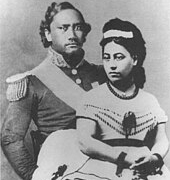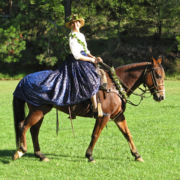Queen Emma Kaleleonalani and the 36th Annual Emalani Festival
The nation of Hawai’i has had many famous monarchs throughout its history, from the long lines of the Kamehameha Dynasty, to the Renaissance King Kalākaua. Almost as powerful as the ali’i (royalty) on the throne, however, were the wives at their side. One such woman, Queen Emma Kaleleonālani, the wife of Kamehameha IV, rose to prominence as a champion of the Hawaiian people, particularly Hawaiian women and the poor. Now, every year on Kauai’s South Shore a festival is held in her honor, and to commemorate the historic journey Queen Emma took to Koke’e in 1871 while grieving the loss of her husband and child. Read on to learn more about this powerful figure, and to find out more about the Eō e Emalani Festival!
From Emma to Emalani: the Queen’s Early Life and Rise to Prominence

Queen Emma and King Kamehameha IV
Even from the time of her birth in 1836, Emma, or Emalani (Royal Emma) as she was often called, was an important person to the upper castes of Hawaiian society. Born to a high chief and chiefess, and adopted into the family of high chiefess Grace Kamaʻikuʻi Young Rooke and physician Thomas Rooke, Emma was raised in high society, and attended the Royal School with other children of Hawaiian ali’i. Her classmates included her future husband and king of Hawai’i, Alexander Liholiho, as well as future king and queen David Kalākaua and Liliʻuokalani. Even though Emma was the great-grandniece of Kamehameha I, because her heritage was mixed Hawaiian and British, some thought her unfit to marry King Kamehameha IV. Nonetheless the two were wed in a happy ceremony, and two years later they had their only son, Prince Albert Edward Kamehameha.
A Champion of the People: The Queen’s Hospital and School for Girls
While Kamehameha IV was alive, Queen Emma undertook two significant projects to help her people. The first was Queen’s Hospital in Honolulu, now known as the Queen’s Medical Center. Inspired by her adoptive father’s work as a physician, and further pushed by the growing number of Native Hawaiians dying due to foreign diseases like smallpox, Emma and Kamehameha campaigned door-to-door for donations for the establishment of a public hospital, and in 1859 the Queen’s Hospital was opened to “protect the Hawaiian race”. The hospital offered free healthcare services to poor Hawaiians, most notably free smallpox vaccines, and Queen Emma was said to have visited most every day she was in Honolulu. Queen’s Medical Center remains a world-renowned hospital, and a continuous pillar of financial support for Native Hawaiian health programs.
Emma’s other humanitarian undertaking was the establishment of St. Andrew’s Priory school for girls in 1867. Although Emma was rigorously schooled at the American-style Royal School, this was a privilege afforded to her only due to her status as royalty. In broader Hawaiian society, it was typical that only boys were allowed to attend schools, and Queen Emma sought to rectify this by establishing an all-girls school that would provide a high quality education like that of the boys’ schools. After traveling to England to seek the counsel of the Archbishop of Canterbury, Emma returned to Hawai’i with the Sisters of the Church of England, and the school was opened on Ascension Day in 1867. Like the Queen’s Hospital, St. Andrew’s is still operational to this day, and continues to offer high quality education for the young girls of Hawai’i.
The Loss of Kamehameha IV, Prince Albert Edward, and Emma’s Journey to Kaua’i

Emma Kaleleonālani in traditional widower’s weeds after the death of her husband Kamehameha IV
Despite the happy marriage between Emma and Kamehameha IV, their son Albert Edward fell seriously ill and died in 1862 at just 4 years old. Both parents were grief-stricken, and Queen Emma came to be known as Kaleleokalani, meaning “the flight of the heavenly chief” in remembrance of her son. King Kamehameha IV became severely depressed due to the loss of his son, and considered abdicating the throne to mourn in peace with his wife. Unfortunately, his depression over the loss of his son led to his worsening health, and in 1863 King Kamehameha IV died at just 29 years old. Now grieving the loss of both husband and child, Queen Emma once again changed her name to Kaleleonālani, “the flight of the heavenly chiefs”, to honor both Kamehameha and Albert Edward. Although she was just 27, Kaleleonālani would not remarry, nor have any more children.
After several years spent traveling the world for personal and religious purposes, Emma Kaleleonālani came to Kaua’i in December of 1870 to heal her wounded soul. She resided in a humble cottage in Lawai on the South Shore, and spent her time tending to her beautiful and extensive garden, and walking by the bluffs in solitude. In January of 1871, wishing to see the beautiful Kilohana of Hanalei (a breathtaking viewpoint of Hanalei town and the Pacific Ocean from the mountain cliffs), Queen Emma set off with her guide Kaluahi and a party of about 100. Starting in Waimea, and continuing through Koke’e and the Alakai Swamp, the group trekked for two days, with Emma keeping spirits high through chants and hula performances the whole time. When they returned from the journey, the Queen was celebrated with a grand luau, which served as the inspiration for today’s Emalani Festival!
10 years later, in 1882, Emma Kaleleonālani would again return to Kaua’i, this time to climb to the top of Mauna Kea, the highest and most sacred mountain on Kaua’i. At the top was a spring fed lake, called Wai’au, believed to have sacred, life-giving waters, where Queen Emma swam before beginning the grueling descent back down the mountain. Although her 1871 trip to the Kilohana of Hanalei was met with more fanfare, the symbolism of Queen Emma climbing the sacred peak inspired no less than 8 meles (chants/poems) to be composed.
The Annual Emalani Festival

A previous “Queen Emma” arriving at the Festival on horseback.
Since 1988, to honor Queen Emma Kaleleonālani’s first journey to Kaua’i, an annual Emalani Festival has been held in November. Each year people are chosen to represent Queen Emma, her guide Kaluahi, and her attendants, and many hālau (groups or schools) are invited to perform in her honor, much like the original grand luau that was held. Performances include traditional Hawaiian music, chants, and dances, and there is traditional Hawaiian food, lei making, and exhibits available for attendees. Each festival, Queen Emma and her entourage arrive on horseback at 10am, marking the official start of the festivities. From there the hālau will perform in her honor and, as is customary, the Queen may offer a dance of her own in thanks. This beautiful and interesting event is an opportunity to witness the recreation of a historical event, try some genuine Hawaiian cuisine, and witness traditional Hawaiian ceremonial protocol. Attendance is free for all, and the Festival will take place Saturday, November 2nd 2024, from 9am to 4pm in Koke’e State Park. You can park at the Kekaha Neighborhood Center and follow the signs to the Festival from there! For more information you can click here or here. Although the bulletin is several years old, we found the program for the 2020 virtual event to be quite interesting when putting this blog post together. If you’d like to look over it, you can do so here.
